September 2010
Welcome to this issue of the Hardwood Tree Improvement and Regeneration Center E-newsletter. The HTIRC is committed to enhancing the productivity and quality of Central Hardwood Region trees and forests for the economic and environmental benefits they provide. Scientists at the HTIRC are using conventional tree improvement breeding as well as molecular and genetic technologies to improve the wood quality, growth characteristics, and insect and disease resistance of trees like black walnut, black cherry, red and white oaks, butternut and American chestnut.
Research in tissue culture, tree nursery practices, tree plantation establishment and management, and Central Hardwoods silvicultural systems is aimed at increasing the regeneration
success rate for high quality hardwood trees and forests. Some interesting and unusual research areas include examining the potential for propagating trees with “figured” wood: birds-eye maple or curly walnut; and breeding trees that will be an economical source of bio-fuels.
Twice per year, we will attempt to provide interesting and useful information on Central Hardwood trees and forests, as well as sources for additional information and assistance.
Please pass this newsletter along to others who may enjoy or benefit from the information provided. If you would like a closer look at the HTIRC, please visit our web site at: http://www.htirc.org
Thousand Cankers Disease Found in the Native Range of Black Walnut
Thousand Cankers Disease (TCD) is a disease currently killing black walnut trees in the western United States. This disease was thought to be found only in the western U.S., outside of the native range of black walnut, until black walnut trees infected with TCD were found near Knoxville, Tennessee in July, 2010. Early indications suggest the disease has been in Tennessee for several years and has infected and killed walnuts in urban areas in the Knoxville area and surrounding counties. It is not yet known if black walnuts in woodland environments have been infected. Now that TCD is known to infect and kill trees in the native range of black walnut, controlling the spread of TCD and researching ways to protect the walnut resource in the eastern United States are important goals.
One important tool for managing this disease will be scouting and identification of infected trees. Familiarity with the biology and symptoms of TCD infection can help locate TCD outbreaks and enhance control efforts. Tiny walnut twig beetles (figure 1) bore into stems and branches of walnut trees and carve out galleries beneath the bark where mating and egg laying occurs. The beetles carry on their bodies spores of the Geosmithia fungus, which form small cankers (figure 2) under the bark on the phloem. Huge numbers of beetles, and subsequent cankers, may infest branches. As the cankers gradually grow together, the branches are girdled and the foliage begins to yellow and wilt (figure 3). The tree is normally dead within 2 to 3 years of the first signs of foliage yellowing and wilting.
Some signs of TCD infection:
- Yellowing, followed by wilting and browning of foliage during the growing season. The wilted leaves may remain attached to the twigs. This initially may be limited to scattered limbs in the tree crown, resulting in limb dieback. Black walnut leaves normally yellow and drop early in the fall due to anthracnose and other leaf pests, but wilting does not normally occur.
- Tiny holes in branches, smaller than the diameter of a pencil lead, associated with beetle entrance and exit boring (figure 4).
- Numerous circular or oblong cankers located under the inner bark on the phloem of branches. Gently scraping off the bark will reveal these cankers – they do not extend into the wood.
- The galleries created by the walnut twig beetle will normally be associated with the cankers.
- Additional diagnostic information is available at the Colorado State University Thousand Cankers Disease and Walnut Twig Beetle web page
If you see walnut trees demonstrating these symptoms, contact your state forestry agency or plant pest diagnostic lab for assistance with confirmation of infection.
TCD poses a very serious threat to the walnut resource in North America. Black walnut has historically been the most valuable eastern hardwood veneer and lumber species, and represents millions of dollars of value in standing timber and industry production based on the resource. To address this threat, many states in the native range of black walnut have imposed quarantines preventing the movement of materials that might carry TCD from infected to uninfected areas. As individuals, we can help in this effort by not moving hardwood firewood, walnut bark, lumber, or craft wood, or walnut trees, seedlings, or plant parts. TCD is not believed to be found in walnut nuts. Kiln-dried, bark-free, square-edged walnut lumber may be moved, but must receive certification for transport if traveling from or through quarantined areas.
The other important action for owners of walnuts to take is not to jump into a decision to sell or cut down the walnuts on your property. The geographic extent, rate of spread, and activity of this disease on native forest-grown walnuts in the east is not yet known. There might be undiscovered natural resistance to TCD in the native walnut population. Consult with a qualified and trusted professional forester or certified arborist before making any decisions to market or remove walnut due to concerns about TCD.
Two western walnuts, Arizona walnut and little or Texas walnut, appear to be unaffected by TCD and may be a source of resistance that could be bred into the eastern black walnut. The HTIRC is currently cooperating with several other organizations on TCD research. HTIRC has started experimental crossing of Arizona and black walnut to investigate the potential for breeding resistance to TCD into eastern black walnut. In addition, HTIRC has plantings of several families of black walnut in the western U.S and Tennessee that may serve as screening sites for family differences in resistance to TCD.
For additional information on TCD, refer to the following sites:
U.S. Forest Service Pest Alert –
http://na.fs.fed.us/pubs/palerts/cankers_disease/thousand_cankers_disease_low_res.pdf
Purdue University TCD information – http://www.ppdl.purdue.edu/PPDL/hot10/8-23.html
The Walnut Council TCD information – http://www.walnutcouncil.org/thousand_cankers_disease.htm
.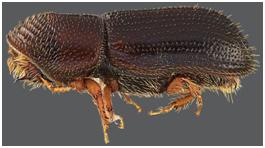
Figure 1. Walnut Twig Beetle. Actual size is 1.5 to 2 mm.
Photo by Jim LaBonte, Oregon Department of Agriculture.
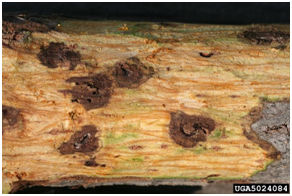
Figure 2. Twig beetle galleries and Geosmithia cankers.
Photo by Whitney Cranshaw, Colorado State University, www.forestryimages.org
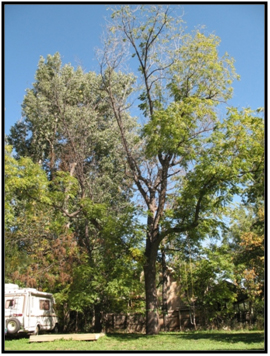
Figure 3. Leaf yellowing, wilting and branch dieback
Photo from Ned Tisserat, Colorado State University
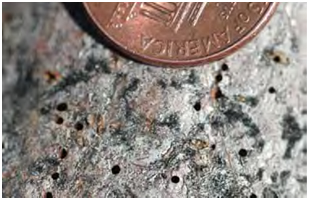
Figure 4. Exit holes made by adult walnut twig beetles
Photo by Whitney Cranshaw, Colorado State University, www.forestryimages.org
New Publication from the HTIRC Highlights Invasive Plant Threats to Tree Plantings
Research has established the benefits of weed control for the survival and growth of hardwood tree seedlings. Grasses, forbs, and invading trees and shrubs can often out-compete planted seedlings, resulting in reduced survival and growth. In addition, some weed species are particularly undesirable because they are considered invasive: they grow rapidly and dominate natural areas, crowding out native plant species and spreading aggressively into new areas. Some examples include the ornamental shrub burning bush (figure 5), Asian bush honeysuckles (figure 6), and Canada thistle (figure 7). Tree plantations may be inviting sites for these invaders to establish and spread due to the availability of bare soil, sunlight, and nutrients. These plants may be exotic or native species, but share the growth and dispersal capacity to competitively dominate other vegetation, often leading to a decline in the productive capacity of desirable plants and the quality of the site for wildlife. Identification and management of these invasive plants may be very important to the long-term productivity of your woodland or plantation.
A recent publication from the HTIRC aims to help landowners and managers identify and manage common invasive plant species threatening tree plantations and forests. Rochelle Beasley and Dr. Paula Pijut authored Invasive Plant Species in Hardwood Tree Plantations, describing over three dozen plant species that may invade tree plantations or forests in the Central Hardwood Region. Identifying characteristics, invasion impacts, and control recommendations are included for each species, as well as links to additional information resources. This publication will be a valuable resource for anyone interested in recognizing and controlling invasive plants in their woodlands or tree plantings. Once invasive plants are established in high densities or over large areas, loss of diversity and productivity may be profound and control becomes very expensive. Early recognition and control of invasive plant infestations is key to maintaining the productivity and integrity of your woodland or plantation.
Purdue University Department of Forestry and Natural Resources and the HTIRC will be sponsoring an Invasive Plant Management Field Day at the Wright Forestry Center, 7 miles west of West Lafayette, Indiana. If you are interested in learning more about invasive plant threats and methods to manage these invaders you can discover more about the program and download the registration brochure at http://www.ag.purdue.edu/fnr/Documents/temp/InvasivesWrightCtrWorkshop.pdf
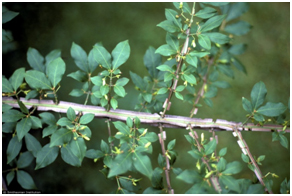
Figure 5. Burning Bush, Euonymus alatus

Figure 6. Asian Bush Honeysuckle, Lonicera spp.

Figure 7. Canada Thistle, Cirsium arvense
Identifying and Managing Butternuts
Butternut, or white walnut, is a fine hardwood tree native to the Central Hardwoods Region. Butternut has become quite rare, due primarily to the ravages of a fungal disease known as butternut canker. Butternut canker gradually kills butternuts as individual cankers on the stems, trunk, and root flares coalesce and girdle the tree. The HTIRC and several partnering groups and individuals are working toward conserving butternut and returning the species to its former position as an important hardwood tree used for high quality wood products, nut production, wildlife food source, and various traditional uses including dyes, sap sugar, and carving wood.
One of the first steps to conserve butternut is accurately identifying butternut trees. As butternut trees disappear, fewer people are familiar with the tree and recognize it when encountered. In addition, butternut has hybridized with Japanese walnut or heartnut, which was introduced to North America over 100 years ago as a nut tree. These hybrids are very similar in appearance to true butternut, sometimes causing seed collectors and tree breeders to make mistakes in their identification. In fact, when butternut back-crosses with these hybrids, genetic testing may be the only reliable way to separate the pure butternuts from the hybrid plants. The hybrids are not necessarily undesirable. They are normally vigorous growers and highly productive nut producers, and often demonstrate increased resistance to butternut canker. Hybrids may be an important part of future breeding programs to conserve butternut as a species, but it is important to differentiate butternuts and hybrids when collecting seed or plant material for propagation, to conserve the genetic integrity of our native butternut.
Hybrid trees are normally planted or have grown from seed dispersed from planted trees, so large, healthy trees near homes, farms, parks, or other locations where trees might be planted are often hybrids instead of pure butternut. Several field characteristics may help to identify butternuts and hybrids. Both hybrids and pure butternut have mature bark composed of interlacing ridges and fissures, but the fissures on butternut are dark gray, while the bark fissures of hybrids are tan or even pinkish (figure 8). Butternut tends to lose its leaves early in the fall, about the same time as black walnut. The hybrids tend to hold their leaves much longer, and in some cases the leaves remain green until a hard frost kills them (figure 9). Butternut nuts (the woody seed inside the fleshy hull) tend to be round in cross-section and have very sharp corrugations on the surface of the nut. Hybrid nuts are highly variable, but tend to be angular or flattened in cross-section with blunt corrugations or no corrugations at all (figure 10). For additional information please refer to the recent HTIRC publication Identifying Butternuts and Butternut Hybrids.
Butternut can still be found in forests and abandoned farms or pastureland, and some actions can be taken to enhance the vigor of existing trees and encourage regeneration of new trees. Managing existing trees and planting or encouraging the natural regeneration of new trees is a way to conserve the genetic diversity of this native species. Butternut requires full sunlight to regenerate and grow. The vigor of existing trees can be enhanced by killing or cutting trees actively competing with the butternut for sunlight and growing space. Nuts can be collected and planted, if you can beat the squirrels to them, either as a direct planting or for producing a seedling to be transplanted. Details on seed collection, planting, and other techniques to encourage the regeneration and growth of butternut can be found in the publication Conservation and Management of Butternut Trees . Butternuts that are infected with butternut canker will ultimately be killed by the disease, but efforts to maintain tree vigor and regenerate new generations of butternuts will help maintain the species on the landscape until disease resistant trees are available.
The HTIRC is currently screening one of the largest collections of butternut trees from across the species range, looking for butternut canker disease resistance in butternut and butternut hybrids. As we identify potentially resistant families, we will establish seed orchards and continue testing, with the goal of providing disease resistant planting stock for re-establishing butternut as a healthy member of the central hardwood forest. Thanks go to the many people and organizations that have provided seed or information on the location of butternut trees for this important research. If you would like to learn more about our butternut research please click on “Butternut Links” on the HTIRC website.
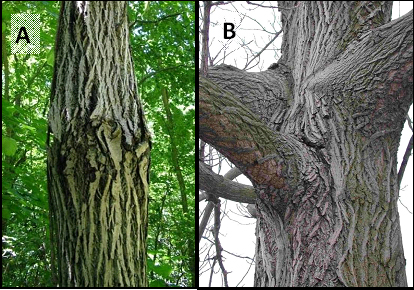
Figure 8. Flat gray ridges and darker fissures typical of mature butternut bark (A), and light ridges and tan or even pinkish fissures typical of mature butternut hybrids- notice the underside of the branches (B).
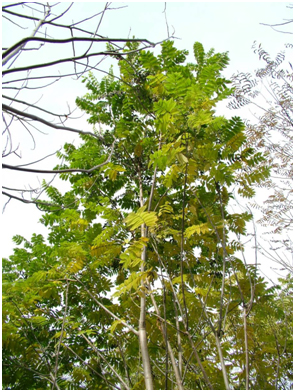
Figure 9. Hybrid butternut trees may retain green foliage until a killing frost, while pure butternuts have dropped all leaves two or more weeks earlier.
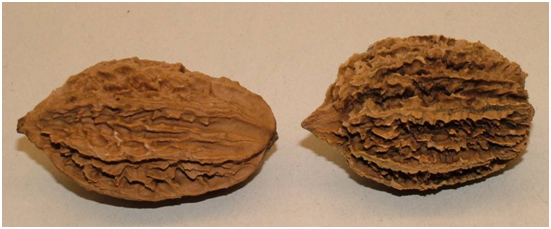
Figure 10. Hybrid butternut (left) and Butternut (right)
Molecular Approaches in Natural Resource Conservation and Management
Recent advances in molecular genetics and genomics have been embraced by many in natural resource conservation. Today, several major conservation and management journals are now using “genetics” editors to deal solely with the influx of manuscripts that employ molecular data. The editors have attempted to synthesize some of the major uses of molecular markers in natural resource management in a book targeted not only at scientists but also at individuals actively making conservation and management decisions. To that end, the text features contributors who are major figures in molecular ecology and evolution – many having published books of their own. The aim is to direct and distill the thoughts of these outstanding scientists by compiling compelling case histories in molecular ecology as they apply to natural resource management.
Nationally known editors include:
J. Andrew DeWoody, Professor of Genetics and University Faculty Scholar, Purdue University
John W. Bickham, Professor in the Department of Forestry and Natural Resources and Director of the Center for the Environment, Purdue University
Charles H. Michler, Fred M. van Eck Director of the Hardwood Tree Improvement and Regeneration Center, Purdue University
Krista M. Nichols, Associate Professor in the Department of Biological Sciences and Forestry and Natural Resources, Purdue University
Olin E. Rhodes, Jr., former Professor of the Department of Forestry and Natural Resources and Director of the Interdisciplinary Center for Ecological Sustainability, Purdue University
Keith E. Woeste, Research Molecular Geneticist for the USDA Forest Service Northern Research Station Hardwood Tree Improvement and Regeneration Center and Adjunct Assistant Professor in the Department of Forestry and Natural Resources
For contents and contributors follow this link: Molecular Approaches in Natural Resource Conservation and Management
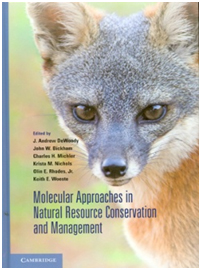
Invasive Plant Management Field Day October 13, 2010
Purdue University Department of Forestry and Natural Resources and the Hardwood Tree Improvement and Regeneration Center are sponsoring a program to help landowners and resource professionals effectively manage invasive species in forested and wildland habitats. Identification and management techniques will be covered in classroom and field presentations. To find out more about the program or to register follow this link or contact Lenny Farlee.
Have questions about tree planting? This series of publications can be viewed or downloaded free of charge. Planting and Care of Fine Hardwood Seedlings
Van Eck Scholarships available for graduate research with the HTIRC.
Ask the HTIRC: email Lenny Farlee with your tree planting and forest management questions and we’ll help you find the answers.
